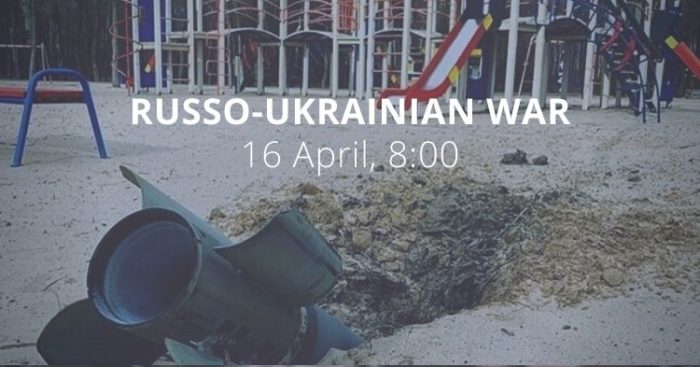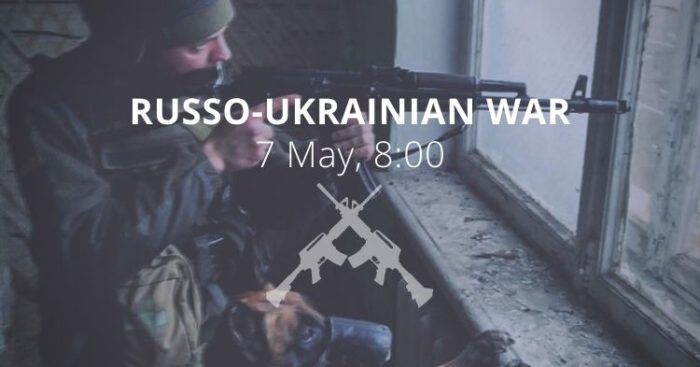Russian forces continue to launch missile strikes on Ukrainian infrastructure and are trying to launch an offensive in some areas. Rocket attack hit and partially destroyed a military factory outside Kyiv. Airstrikes on the city of Mariupol continue. Russian military fired at evacuation buses in the Kharkiv Oblast, killing 7 civilians and injuring 27.
Morning report day 52 – April 16
Situation
According to information from the General Staff:
During today the situation has not changed significantly in any direction. Russian forces continue to launch missile strikes on industrial and civilian infrastructure in Ukraine and are trying to launch an offensive in some areas. Airstrikes on the city of Mariupol continue. The most active actions of Russian forces are recorded in Slobozhansky and Donetsk directions. In the Volyn, Polissya and Siversky directions, the enemy did not take active action. There is a relocation of presumably separate units of the 35th and 36th Combined Arms Armies of the Eastern Military District. Trucks and special vehicles and refuellers move to loading areas. In the Slobozhansky direction, the Russian forces continue to fight involving separate units of the 6th and 20th Combined Arms Armies, the 1st Tank Army of the Western Military District, the 35th and 36th Combined Arms Armies, and the 68th Army Corps of the Eastern Military District, airborne troops and coastal troops of the Baltic and Northern Fleets. In the Donetsk and Tavriya directions, the Russian forces are trying to hold the occupied territories. Focuses the main efforts on taking control of the settlements of Popasna and Rubizhne, establishing full control over the city of Mariupol. Takes measures to restore combat capability and replenish ammunition. Trying to improve the tactical position. Continues shelling in most directions. In the Pivdennyi Buh direction, the enemy’s actions were characterized by measures to restore combat readiness, replenish reserves, and engineering equipment positions in the areas of Lyubymivka, Petrivka, Khreschenivka and strengthen their advanced positions, probably units of the mobilization reserve of the 1st and 2nd Army Corps. In the waters of the Sea of Azov, the Russian naval group continues to carry out tasks to block the port of Mariupol and provide fire support in the coastal direction. Due to the presence of Russian warships in the Black Sea, armed with naval cruise missiles “Caliber”, there is an increased level of threat of use of missiles by the Russian occupiers on the defense industry and logistics infrastructure of Ukraine. The Air Force of the Armed Forces of Ukraine has hit seven air targets the previous day: one plane, one helicopter, three UAVs and two cruise missiles. In order to suppress Ukrainian resistance, the Russian forces are filtering and searching for people involved in military service. Units of the Defense Forces of Ukraine continue to maintain certain defensive lines, inflict losses on the enemy and gradually liberate settlements from the troops of Russian forces.”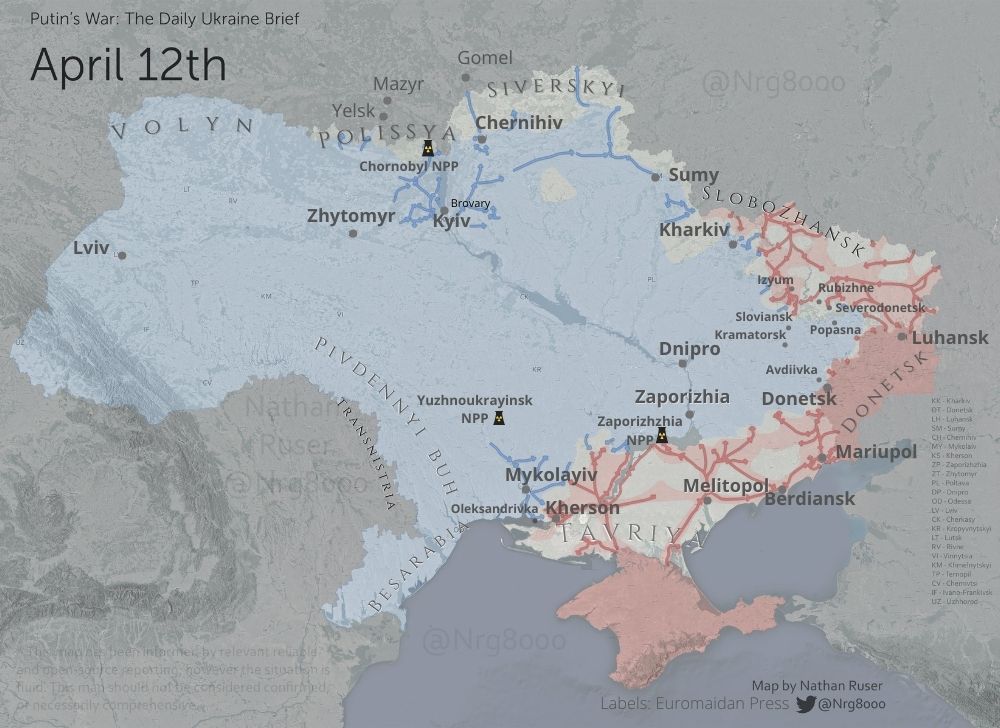
Two formations of Russian Navy warships, likely including Landing ships, were seen steaming northwest at around 6.30 pm local time on 15 April a radar satellite showed, Navalnews reports. Their direction suggests that they are sailing toward the Ukrainian coast.
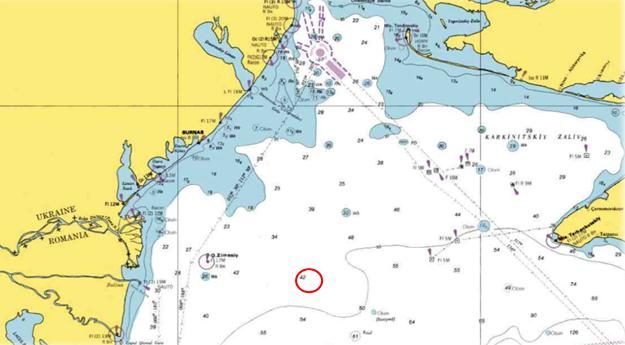
Experts fear the Russian flagship Moskva had Nuclear Weapons on board when it sank after the missile attack, the Mirror reports. The Moskva may have had nuclear cruise missiles on board when it sank after a Ukrainian missile attack. BlackSeaNews editor-in-chief Andriy Klymenko called for an urgent international probe into whether the Moskva was carrying nuclear weapons. “Friends and experts say that there are two nuclear warheads for cruise missiles onboard the Moskva,” he said. The ship is believed to have sunk around 45°10’43.39″N, 30°55’30.54″E at around 42 m water depth according to Navalnews. This position is east of Zmiinyi (Snake) Island, 80 nautical miles from Odesa and 50 nautical miles from the Ukrainian coast.
The Russian Defense Ministry has said it plans to launch missile strikes “on targets” in Kyiv, Ukrainska Pravda reports. The Russian military, according to the SBU, fired on the village of Klimovo in the Bryansk region of Russia, and Moscow accused Ukraine of shelling. After provoking Russian troops on its own territory, Russia warned that it would fire missiles at Kyiv. “The scale of missile strikes by the Russian Armed Forces on facilities in Kyiv will increase in response to any attacks or sabotage in Russia,” the Russian Defense Ministry said. The Center for Countering Disinformation at the National Security and Defense Council of Ukraine explained that Russia’s special services have begun implementing a plan to carry out terrorist attacks on its territory to fuel anti-Ukrainian hysteria among Russians. In large cities, in particular, Kyiv, there is a significant danger of missile strikes in the coming days. Russia may attempt to attack from the air. The biggest threat is until April 18 inclusive.
Residents of Kyiv Oblast are being injured and killed by mines and explosives Russian soldiers left in private houses, cars, on the roads,–Internal Affairs Ministry of Ukraine https://t.co/mAns1B0NcI pic.twitter.com/SqftRZyTAw
— Euromaidan Press (@EuromaidanPress) April 15, 2022
Russian Strike Hits Missile Unit Outside Kyiv, AFP reports. A Ukrainian military factory outside Kyiv that produced missiles allegedly used to hit the Russian cruiser Moskva was partly destroyed by overnight Russian strikes.
“A workshop and an administrative building at the Vizar plant, in the Kyiv suburb of Vyshneve near the international Zhuliany airport, were seriously damaged. Russia had earlier announced it had hit the factory using Kalibr sea-based long-range missiles. The strike came a day after Ukraine claimed it had destroyed Russia’s Moskva warship, which Moscow later said had sunk.”
According to British Defense Intelligence, (last 24 hours):
- Road infrastructure in conflict-affected areas of Ukraine has sustained significant damage. Russian troops have exacerbated this by destroying bridges, employing land mines and abandoning vehicles along key routes as they withdrew from northern Ukraine.
- The destruction of river crossings in and around Chernihiv has left only one pedestrian bridge in the city itself across the Desna River. Prior to the war, the city had approximately 285,000 residents.
- Damage to Ukraine’s transport infrastructure now presents a significant challenge in delivering humanitarian aid to areas formerly besieged by Russia.Ukraine.
As of Friday 15.04.2022, the approximate losses of weapons and military equipment of the Russian Armed Forces from the beginning of the war to the present day:
- Personnel – more than 20000 people (+100),
- Tanks – 756 units (+3),
- Armored combat vehicles – 1976 units (+8),
- Artillery systems – 366 (no change),
- Multiple rocket launchers – 122 (no change)
- Air defense means – 66 (+2),
- Aircraft – 163 (+3),
- Helicopters – 144 (no change),
- Automotive technology – 1443 (+6),
- Vessels/boats – 8 units (+1),
- Fuel and lubricant tanks – 76 (no change),
- UAV operational and tactical level – 135 (+1)
- Special equipment – 25 (no change)
- Mobile SRBM system – 4 (no change)
Ukrainian officials estimate that between 2,500 and 3,000 Ukrainian servicemen were killed in the war, CNN reports citing President Zelenskyy, Zelenskyy added that about 10,000 Ukrainian servicemen were injured and that “it is difficult to say how many of them will survive.”
Humanitarian
According to UNHCR 4,796,245 refugees have been registered as of April 14. The UN says that so far Poland has taken in 2,720,622 refugees, Romania 726,857, Russian Federation 484,725, Hungary 447,053, Republic of Moldova 419,499, Slovakia 329,597 and Belarus 22,827. Among those who fled Ukraine are also Ukrainian nationals with dual citizenship. An additional 113,000 people moved to the Russian Federation from the Donetsk and Luhansk regions between 21 and 23 February.
OHCHR recorded 4,633 civilian casualties in Ukraine as of April 14: 1,982 were killed (including 162 children) and 2,651 injured (including 256 children).
The agreed humanitarian corridors ensured the evacuation of 2,864 civilians on April 15. According to the Deputy Prime Minister and Minister of Reintegration of Temporarily Occupied Territories of Ukraine:
“2,494 people travelled to Zaporizhzhia by own vehicles from the Mariupol and Berdiansk using humanitarian corridors. 363 of them were from Mariupol; 2,131 – arrived from the cities of Zaporizhzhia oblast: Polohy, Vasylivka, Berdiansk and Melitopol.
Amid continuous shelling, 370 civilians evacuated from the cities of Luhansk oblast: Lysychansk, Sievierodonetsk, Rubizhne, Kreminna and Popasna, and the village of Hirske.”
Today in Lysychansk (Luhansk Oblast), a couple of volunteers came under Russian shelling. A man was killed, and a woman in intensive care.
From the first days of the full-scale war, the couple provided humanitarian aid to the residents,–Oblast Head https://t.co/oaDH0EIBbm pic.twitter.com/7wS9hwOCHg
— Euromaidan Press (@EuromaidanPress) April 16, 2022
Environmental
In the article “As Russia’s war against Ukraine escalates, the threat of hunger looms over the world” (EuromaidanPress), Mykhailo Amosov and Maria Diachuk, Ecoaction Center for Environmental Initiatives, outline some of the global consequences of Russia’s unjust and unprovoked war against Ukraine.
According to international sources, Ukraine is one of the leading suppliers of wheat, barley, maize, rapeseed, sunflower seeds oil, and rapeseed oil. Our country’s share in global grain export alone was 10% in 2020-21 and 14% in 2021-22. Ukraine is also the country of origin for half of the World Food Programme’s grain procurements for about 120 million malnourished people. Buying from us was cost-effective and logistically convenient, that is before Russia blockaded the Ukrainian ports and mined nearly half of the Black Sea. Russia’s war against Ukraine has already led to a drastic reduction in the grain supply and increased the global prices several times over, which, in turn, is going to wreak havoc with the budgets of African and Asian countries as early as next quarter. Indeed, according to Kyiv School of Economics, just one week after the Russian invasion of Ukraine, the price of wheat surged by 26%. This will surely have dire consequences for the importers of Ukrainian wheat, the top five of which in 2015 included, according to data provided by the UN World Food Programme, Egypt, Indonesia, Bangladesh, Pakistan, and Türkiye. The population of those five countries alone stands at 700 million people. […] Russia’s war against Ukraine has put the world in a very awkward position in terms of food security. Many countries depend on exports of Ukrainian goods, which have now been drastically reduced or even completely cut off. Not only have Russia’s actions in Ukraine caused local humanitarian catastrophes in Mariupol, Kharkiv, and Kherson, they can cause a food crisis in many countries of the world. It is therefore imperative that the entire world, each and every country, must make an effort to stop the Russian aggression against Ukraine as soon as possible.
Legal
Russian army damaged 324 hospitals in Ukraine, Ukrinform reports. The Russian army has damaged 324 hospitals, including 14 children’s hospitals, since the full-scale invasion of Ukraine began on February 24. This was reported by Ukrainian human rights commissioner Liudmyla Denisova on Telegram.
“Because of the damage done, the rights of Ukrainian citizens to life and medical care have been violated – the right to the emergency, palliative care, care during childbirth and psychological assistance, Denisova said.
According to Articles 18 and 20 of the Geneva Convention relative to the Protection of Civilian Persons in Time of War of August 12, 1949, civilian hospitals organized to give care to the wounded and sick, the infirm and maternity cases, may in no circumstances be the object of attack, but must always be used, but shall at all times be respected and protected by the parties to the conflict.
According to Denisova, such actions by the Russian army are war crimes in accordance with Article 8 of the Rome Statute of the International Criminal Court.”
Russians fired at evacuation buses in the Kharkiv region, Ukrinform reports. On April 14, Russian forces fired at evacuation buses in the Kharkiv oblast, killing 7 people and injuring 27, according to the press service of the Kharkiv regional prosecutor’s office. According to the regional prosecutor’s office, local residents said that the bus drivers, seeing the Russian troops, stopped on the sidewalk and got out of the vehicles with their hands up, but the occupiers opened fire at people.
200 children were killed, and 360 children injured, the Office of the Prosecutor General of Ukraine reports that as of 8 a.m. on April 16. 6889 crimes of aggression and war crimes and 3157 crimes against national security were registered as of the same date. 1018 educational establishments are damaged as a result of shelling and bombings, 95 of them are fully destroyed.
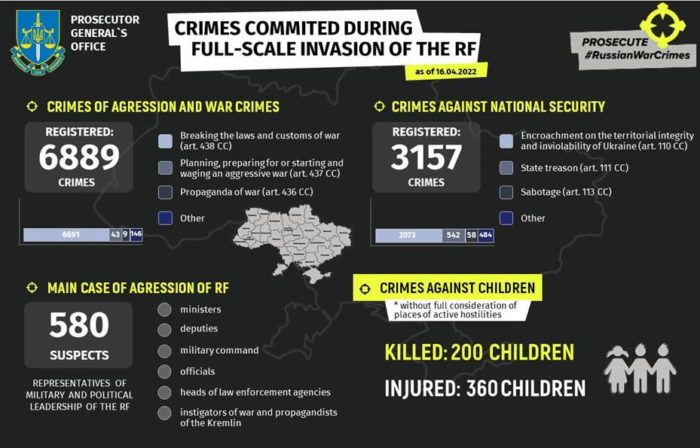
Law enforcement officers have found more than 900 bodies of civilians in Kyiv oblast, Ukrainska Pravda reports. Police have already found more than 900 bodies of civilians in the settlements of Kyiv oblast, which were liberated from the Russian occupiers, most of them with gunshot wounds.
The General Staff of Ukraine claims:
- In violation of the norms of International Humanitarian Law, the Russian occupiers in the temporarily occupied territories continue to oppress the rights of Ukrainian citizens. Violating the rules of warfare, sabotage and reconnaissance groups of the enemy, to carry out sabotage on the territory of Ukraine, steal or, threatening physical violence, take away motor vehicles and civilian clothes from local residents.
- In the areas of Luhansk oblast temporarily occupied by the Russian enemy, the usage of buildings and adjacent territories of secondary schools for the installation of additional field hospitals, places for weapons, ammunition and military equipment are recorded.
- In some settlements, the Russian forces are trying to imitate elections and illegally appoint “local governments” from among local residents loyal to the occupying power.
Support
Security Assistance Support to Ukraine Not Affecting US Readiness, US Department of Defence said.
According to a Defense Department fact sheet published today, as of April 14, the US has provided or committed to providing Ukraine, with more than 1,400 Stinger anti-aircraft systems; 5,500 Javelin anti-armor systems; 700 Switchblade tactical unmanned aerial systems; 7,000 small arms; 50,000,000 rounds of ammunition; and 18 155mm Howitzers with 40,000 155mm artillery rounds; 16 Mi-17 helicopters; hundreds of armored Humvee vehicles and 200 M113 Armored Personnel Carriers.”
The top US commander in Europe and his staff are developing training for Ukrainian forces that will teach the soldiers about weapons new to the country’s arsenal, a senior US defence official said Thursday the Washington Post reports. The training will focus on using 155mm howitzer cannons, counter-artillery radar and Sentinel air defence radars, and will last a few days each, the official said, speaking on the condition of anonymity under ground rules set by the Pentagon.
France had delivered €100 million in weapons to Ukraine, Euractiv reports. France has delivered more than €100 million worth of military equipment to Ukraine since the start of the conflict and will continue to do so, Armed Forces Minister Florence Parly has announced. The Elysée and the armed forces ministry have not yet made public detailed figures on armed shipments to Ukraine. The equipment sent to Ukraine includes “means of protection, optronic equipment, arms and ammunition, and weapons systems that meet the needs expressed by Ukraine,” the ministry added.
Reportedly, Czechia has sent at least 20 RM-70 Vampire MRLS to Ukraine. https://t.co/Yr8hYImcKK
— Euromaidan Press (@EuromaidanPress) April 16, 2022
A full embargo on oil could stop the war, BBC reports citing an ex-Putin aide. Dr Andrei Illarionov said if Western countries “would try to implement a real embargo on oil and gas exports from Russia… I would bet that probably within a month or two, Russian military operations in Ukraine, probably will be ceased, will be stopped”. Last year, soaring prices meant oil and gas revenues accounted for 36% of Russia’s government spending. Much of that income comes from the European Union, which imports about 40% of its gas and 27% of its oil from Russia. According to Josep Borrelll Europe pays Putin one billion euros every day he supplies us with energy. Dr Illarionov said Russia does “not take seriously” other countries’ threats to reduce their energy usage. Despite trying to reduce its reliance on Russian sources, Europe is continuing to buy oil and gas.
New developments
- Zelensky asks Biden to designate Russia a state sponsor of terrorism territory, the Washington Post President Zelensky has made a direct appeal to President Biden for the United States to designate Russia a state sponsor of terrorism, one of the most powerful and far-reaching sanctions in the US arsenal. His request came during a recent phone call with Biden that centred on the West’s multifaceted response to Russia’s invasion of Ukraine, according to people familiar with the conversation.
- Russia warns the US to stop arming Ukraine, Washington Post Russia this week sent a formal diplomatic note to the United States warning that US and NATO shipments of the “most sensitive” weapons systems to Ukraine were “adding fuel” to the conflict there and could bring “unpredictable consequences.” The diplomatic démarche came as President Biden approved a dramatic expansion in the scope of weapons being provided to Ukraine, an $800 million package including 155 mm howitzers, coastal defence drones and armoured vehicles, as well as additional portable antiaircraft and antitank weapons and millions of rounds of ammunition.
- “All of the countries of the world” should be prepared for the possibility that President Putin could use tactical nuclear weapons in his war on Ukraine, President Zelensky told CNN Zelensky told CNN’s Jake Tapper in an exclusive interview from the office of the president in Kyiv on Friday that Putin could turn to either nuclear or chemical weapons because he does not value the lives of the people of Ukraine.
Assessment
On the War
The Institute for the Study of War has made the following assessment as of Friday 15 April:
Russian forces continued to grind down Ukrainian defences in southwestern and eastern Mariupol on April 15, though ISW cannot confirm any major new territorial changes. The commander of Ukraine’s 36th Marine Brigade stated on April 15 that the situation in Mariupol is “deteriorating” and that Russian forces are “aggressively attacking” Ukrainian positions but said Ukrainian forces would not surrender. Petro Andryushenko, advisor to Mariupol’s mayor, said Russian forces are deploying unspecified heavy weapons and artillery to the Iliych area to support assaults on the Azovstal Steel Plant, though ISW cannot independently confirm this report. The Ukrainian Defense Ministry reported that Russian long-range Tu-22M3 bombers struck Mariupol on April 15 for the first time in the war amid continued heavy Russian shelling and widespread reports of damage to the city. Russian forces will likely increase their pace of air and artillery strikes due to the slow pace of ground assaults against entrenched Ukrainian defenders.
Russian forces continued unsuccessful daily attacks against Rubizhne, Popasna, and Marinka and heavy shelling along the line of contact in eastern Ukraine but did not make any territorial advances on April 15. Ukraine’s Defense Ministry stated on April 15 that Russia’s 58th and 8th Combined Arms Armies are the primary Russian forces in Donbas, in addition to the 1st and 2nd Army Corps of the DNR and LNR, respectively. Russian forces likely require a true operational pause to cohere the forces that could enable them to advance through frontal assaults in eastern Ukraine.
Key Takeaways
- Russian forces continued to grind down Ukrainian defences in southwestern and eastern Mariupol, though ISW cannot confirm any major new territorial changes in the past 24 hours. Ukrainian defenders reported that the situation is “deteriorating” and Russian forces are deploying additional artillery and heavy weapons.
- Russian forces continued unsuccessful daily attacks against Rubizhne, Popasna, and Marinka and heavy shelling along the line of contact in eastern Ukraine.
- Ukrainian forces repelled Russian attacks from Izium toward both Sloviansk and Barvinkove.“
In the analysis “Why Russia gave up on urban war in Kyiv and turned to big battles in the east”, the Washington Post explains what “plan A” entailed, why Russia turned to “plan B” and what to expect. […] “They decided [to withdraw] because they had no other decision to make,“ said Jeffrey Edmonds, the former director for Russia on the National Security Council. “It wasn’t like, ‘Well, we can take the city, but it’s going to cost us too much,’ ” said Edmonds, who also served with the US Army in Iraq. “They just couldn’t do it.
Russia began pulling its troops from Kyiv in late March, sending some north to Belarus and others to the Donbas region in eastern Ukraine. […] The open terrain is better for Russian armoured units, experts say. Near Kyiv, they were forced to use roads, putting forces on a predictable route vulnerable to ambushes and attacks from the air.
Satellite images taken by Maxar Technologies have in recent days shown multiple convoys of Russian vehicles, weapons, troops and equipment moving in and around Ukraine’s east. Experts say Russia may try to besiege Ukrainian forces by linking its troops in the north and the south. It is an effort that analysts warn could include the blockade or capture of more eastern cities. […]
To achieve that, analysts say, Russia is likely to try to encircle Ukrainian troops in the east by connecting their troops in the north with their troops in the south. […]
If Sloviansk, a city of more than 100,000, were to fall, it could allow Russia to encircle Ukrainian troops in the east, cutting them off from supply lines.
Other nearby cities, such as Kramatorsk to the south or Sievierodonetsk to the east, could also become surrounded by Russian troops.
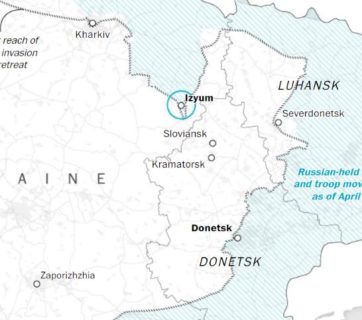
Russia has already used siege tactics in Ukraine, surrounding and bombarding the port city of Mariupol, as well as Chernihiv in the north. Encircling, isolating and then pummeling a city requires less manpower and equipment than an urban war for control of a major capital.
So far, no large eastern city has surrendered to Russian forces — but their defence has come at an enormous cost. The mayor of Mariupol said this week that Russia’s siege may have killed more than 20,000 civilians, a figure The Post could not independently verify.
The devastation itself can make it hard for the aggressor to hold a city, alienating the local population and breeding further resistance.
“The encirclement and siege of key towns and cities are very destructive and impose huge costs on the local population,” said Tracey German, a professor in conflict and security at King’s College London.
“Even if Russia achieves a military victory — which is not a given — it is not clear how it can achieve a longer-term political victory after its destructive and indiscriminate use of force,” she said.
Consequences and what to do?
Russia has a significant advantage in the air, deploying more than three times as many combat aircraft as Ukraine, BBC reports. The US Pentagon says that Russian aircraft have been flying around 250 military missions and carrying out some 30 airstrikes every day. Western officials still say that Russia is struggling to gain air superiority. Russia’s anticipated offensive in the Donbas presents a new, more difficult challenge.
Justin Bronk, a senior research fellow for air power at the Royal United Services Institute, says Russia is likely to have greater freedom of access in the airspace over the eastern region than the rest of the country due to its proximity to Russian controlled airspace. In order to win the fight here, Ukraine requires a mix of long, medium and short-range weapons to provide what’s known as a “layered defence”.
The West has been providing a significant number of short-range surface-to-air missiles. Manpads – man-portable air defence systems – are, however, most effective against low flying aircraft. Russia is mostly using long-range cruise missiles and high-altitude bombing. Ukraine now lacks medium and long-range air defence systems.
A renewed Russian offensive in the Donbas will put another serious strain on Ukraine’s limited air defence. While the focus of the war has turned to Eastern Ukraine, the rest of the country still needs protection. On the ground, we’ve seen evidence that Ukraine has been sending additional air defence systems to the east in recent days. But it can’t afford to redeploy all its air defence systems to the Donbas region. Ukraine is having to use its air defences not just to target Russian aircraft, but also Russian cruise and ballistic missiles. The Pentagon says that Russia has launched 1,550 missiles since the war began.
Russia warns the US to stop arming Ukraine, the Washington Post reports. The formal diplomatic note from Moscow, a copy of which was reviewed by The Washington Post, came as President Biden approved a dramatic expansion in the scope of weapons being provided to the government in Kyiv
“Russia this week sent a formal diplomatic note to the United States warning that US and NATO shipments of the “most sensitive” weapons systems to Ukraine were “adding fuel” to the conflict there and could bring “unpredictable consequences.”
“What the Russians are telling us privately is precisely what we’ve been telling the world publicly — that the massive amount of assistance that we’ve been providing our Ukrainian partners is proving extraordinarily effective,” said a senior administration official, who spoke on the condition of anonymity about the sensitive diplomatic document.
Russia experts suggested that Moscow, which has labelled weapons convoys coming into the country as legitimate military targets but has not thus far attacked them, may be preparing to do so. “They have targeted supply depots in Ukraine itself, where some of these supplies have been stored,” said George Beebe, former director of Russia analysis at the CIA and Russia adviser to former vice president Dick Cheney.
“The real question is do they go beyond attempting to target [the weapons] on Ukrainian territory, try to hit the supply convoys themselves and perhaps the NATO countries on the Ukrainian periphery” that serve as transfer points for the US supplies. If Russian forces stumble in the next phase of the war as they did in the first, “then I think the chances that Russia targets NATO supplies on NATO territory go up considerably,” Beebe said. […]
Russia accused the allies of violating “rigorous principles” governing the transfer of weapons to conflict zones, and of being oblivious to “the threat of high-precision weapons falling into the hands of radical nationalists, extremists and bandit forces in Ukraine.”
It accused NATO of trying to pressure Ukraine to “abandon” sputtering, and so far unsuccessful, negotiations with Russia “in order to continue the bloodshed.” Washington, it said, was pressuring other countries to stop any military and technical cooperation with Russia, and those with Soviet-era weapons to transfer them to Ukraine.
“We call on the United States and its allies to stop the irresponsible militarization of Ukraine, which implies unpredictable consequences for regional and international security,” the note said.
Andrew Weiss, a former National Security Council director for Russian, Ukrainian and Eurasian affairs, and now vice president for studies at the Carnegie Endowment for International Peace, recalled that Russian President Vladimir Putin, in a speech on the February morning that the invasion began, warned that Western nations would face “consequences greater than any you have faced in history” if they became involved in the conflict.
Attention at the time focused on Putin’s reminder that Russia possesses a powerful nuclear arsenal, Weiss said, but it was also “a very explicit warning about not sending weapons into a conflict zone.” Having drawn a red line, he asked, are the Russians “now inclined to back that up?”
Such an attack would be “a very important escalatory move, first and foremost because it represents a threat to the West if they aren’t able to keep supplies flowing into Ukraine, which by extension might diminish Ukraine’s capacity for self-defence.” That risk “shouldn’t be downplayed,” he said, noting the added risk that an attempt to strike a convoy inside Ukraine could go awry over the border into NATO territory.”
Secretary of State Antony Blinken told European allies that the United States believes the Russian war in Ukraine could last through the end of 2022, CNN reports. There is no short-term end in sight to the conflict. Many of the officials who spoke with CNN stressed that it is hard to predict exactly how long the war could go on, but several said that there are no indications that President Putin’s ultimate goals have changed, and it is unlikely he will pursue diplomatic negotiations unless faced with military defeat. […]
“The longer the war goes on, the more brutal the humanitarian toll on the people of Ukraine. And while officials stressed there is likely to be continued international resolve to provide high levels of support to Ukraine, they acknowledged there may be very real practical challenges regarding weaponry that will need to be dealt with as the war wages on.
National security adviser Jake Sullivan said Thursday that the fighting in Ukraine is likely to be “protracted,” and will go on “for months or even longer.”
Some members of Congress and their aides are quietly making a comparison to the Korean War, which lasted for three years.
Two other European officials said they believe that fighting in eastern Ukraine — where Russian forces are expected to launch a new offensive — could last for four to six months and then result in a stalemate.”
Assessment by Hans Petter Midttun
I guess most of us have heard a child’s excuse for a brawl: “It all started when he hit me back!” Today it is also being used by the Russian Federation. Having waged war against Ukraine for more than 8 years already, it argues that any Ukrainian retaliation against Russia on its territory will trigger even more widespread airstrikes, missile strikes and bombing.
Russia threatens the USA and NATO countries with “unpredictable consequences” if they continue helping Ukraine defend itself against Russian brutalities.
It threatens Sweden and Finland with revoking the nuclear-free status in the Baltics if they decide to join NATO.
Russia’s reply to the Western sanctions is more threats: Threat of escalation. The nuclear “card” has been played more than once. Its rhetoric has become increasingly more belligerent and describes our attempt to curb its atrocities as an act of aggression, a total, economic, information, and cultural war against Russia.
Its actions not only threaten the Ukrainian state and nation but also global food security. It undermines the global security architecture itself and consequently, threatens peace, stability, and prosperity
Despite all of this – despite everything that our liberal democracies are based on is at stake – some countries remain reluctant to do what it takes to stop the Russian Federation, apparently believing that everything will return to normal eventually. And while doing that, they themselves introduce the final threat: The threat of making NATO irrelevant and destroying the Alliance from within.
It is hard to accept that the war might continue for 4-6 more months when we know it might be stopped within weeks if the West either introduced full energy sanctions, enforces an UN-mandated No-Fly Zone, started a Humanitarian Intervention operation to help defend Ukraine or all of the above.
I will, however, offer one prediction. The USA and NATO will soon be forced to reconsider their military options as their stocks of weapons and ammunition are running low.
The NATO members have not only downsized their command and force structure for the last two decades. They have also kept their stock of ammunition and spare parts to a minimum. Even more importantly, one might also find that the European defence industry – and therefore their ability to regenerate new forces – has been equally reduced.
This means that NATO might be forced to employ other weapon systems and forces altogether. The longer the energy sanctions remain off the table, the higher the risk for an active NATO engagement in Ukraine.
Read more:
- Russo-Ukrainian war, day 40: Russian frigate hit by rocket
- Ukraine sank Russian landing ship in occupied Azov Sea port
- What weapons for Ukraine would help it win the war against Russia
- Bucha massacre. Ukraine urges ICC to gather evidence of Russian war crimes
- “The Russian military rape women, the dead are just being dumped,” evacuee from Russian-occupied city says
- “They killed my family in cold blood!” Russian military targets civilians fleeing bombardments




